Eigenvector Spatial Filtering Regression Modeling of Ground PM2.5 Concentrations Using Remotely Sensed Data
Abstract
1. Introduction
2. Materials and Methods
2.1. Study Areas
2.2. Ground PM2.5 Concentrations
2.3. Remotely Sensed Data
2.4. Pollution Source Data
2.5. Data Preprocessing
2.6. Spatial Regression with Eigenvector Spatial Filtering
2.7. Model Specification, Assessment and Comparison
2.8. PM2.5 Distribution Mapping and Cause Analysis
3. Results
3.1. Data Review and Pre-Analysis
3.1.1. Dataset Summary
3.1.2. Correlation Analysis
3.1.3. Spatial Autocorrelation Analysis
3.2. ESFR Model
3.3. Model Assessment and Comparison
3.3.1. Model Fit
3.3.2. Model Residuals Moran’s I
3.3.3. Model Cross Validation
3.4. Analysis of PM2.5 Concentrations Based on ESFR model
3.4.1. PM2.5 Distribution Maps
3.4.2. PM2.5 Spatial-temporal Analysis in YRD region
3.4.3. Pollution Sources Analysis
4. Discussion
4.1. Spatial-Temporal Analysis of PM2.5 Concentrations Based on ESFR Models
4.2. Real-Time Monitoring of Ground PM2.5 Concentrations
4.3. Limitations and Future Enhancements
5. Conclusions
Author Contributions
Funding
Acknowledgments
Conflicts of Interest
References
- Wang, J.L.; Zhang, Y.H.; Shao, M.; Liu, X. The quantitative relationship between visibility and mass concentration of PM2.5 in Beijing. J. Environ. Sci. 2006, 18, 475–481. [Google Scholar]
- Pui, D.Y.H.; Chen, S.-C.; Zuo, Z. PM2.5 in China: Measurements, sources, visibility and health effects, and mitigation. Particuology 2014, 13, 1–26. [Google Scholar] [CrossRef]
- Ho, K.-F.; Ho, S.S.H.; Huang, R.-J.; Chuang, H.-C.; Cao, J.-J.; Han, Y.; Lui, K.-H.; Ning, Z.; Chuang, K.-J.; Cheng, T.-J.; et al. Chemical composition and bioreactivity of PM2.5 during 2013 haze events in China. Atmos. Environ. 2016, 126, 162–170. [Google Scholar] [CrossRef]
- Fu, H.; Chen, J. Formation, features and controlling strategies of severe haze-fog pollutions in China. Sci. Total Environ. 2017, 578, 121–138. [Google Scholar] [CrossRef] [PubMed]
- Pope, C.A.; Burnett, R.T.; Thun, M.J.; Calle, E.E.; Krewski, D.; Ito, K.; Thurston, G.D. Lung cancer, cardiopulmary mortality, and long-term exporsure to fine particulate air pollution. JAMA 2002, 287, 1133–1141. [Google Scholar]
- Pope, C.A.; Dockery, D.W. Health effects of fine particulate air pollution: Lines that connect. J. Air Waste Manag. Assoc. 2006, 56, 709–742. [Google Scholar] [CrossRef] [PubMed]
- Dockery, D.W.; Stone, P.H. Cardiovascular risks from fine particulate air pollution. N. Engl. J. Med. 2007, 356, 511–513. [Google Scholar] [CrossRef] [PubMed]
- Tony Cox, L.A., Jr. Caveats for causal interpretations of linear regression coefficients for fine particulate (PM2.5) air pollution health effects. Risk Anal. 2013, 33, 2111–2125. [Google Scholar] [CrossRef] [PubMed]
- Zou, B.; Luo, Y.; Wan, N.; Zheng, Z.; Sternberg, T.; Liao, Y. Performance comparison of lur and ok in PM2.5 concentration mapping: A multidimensional perspective. Sci. Rep. 2015, 5, 8698. [Google Scholar] [CrossRef] [PubMed]
- Wang, J.; Christopher, S.A. Intercomparison between satellite-derived aerosol optical thickness and PM2.5 mass: Implications for air quality studies. Geophys. Res. Lett. 2003, 30. [Google Scholar] [CrossRef]
- Engel-Cox, J.A.; Holloman, C.H.; Coutant, B.W.; Hoff, R.M. Qualitative and quantitative evaluation of modis satellite sensor data for regional and urban scale air quality. Atmos. Environ. 2004, 38, 2495–2509. [Google Scholar] [CrossRef]
- Koelemeijer, R.B.A.; Homan, C.D.; Matthijsen, J. Comparison of spatial and temporal variations of aerosol optical thickness and particulate matter over Europe. Atmos. Environ. 2006, 40, 5304–5315. [Google Scholar] [CrossRef]
- Van Donkelaar, A.; Martin, R.V.; Park, R.J. Estimating ground-level PM2.5 using aerosol optical depth determined from satellite remote sensing. J. Geophys. Res. 2006, 111. [Google Scholar] [CrossRef]
- Zhang, H.; Hoff, R.M.; Engel-Cox, J.A. The relation between moderate resolution imaging spectroradiometer (modis) aerosol optical depth and PM2.5 over the United States: A geographical comparison by U.S. Environmental protection agency regions. J. Air Waste Manag. Assoc. 2009, 59, 1358–1369. [Google Scholar] [CrossRef] [PubMed]
- Xiao, Q.; Wang, Y.; Chang, H.H.; Meng, X.; Geng, G.; Lyapustin, A.; Liu, Y. Full-coverage high-resolution daily PM2.5 estimation using maiac aod in the Yangtze River Delta of China. Remote Sens. Environ. 2017, 199, 437–446. [Google Scholar] [CrossRef]
- Chen, T.; He, J.; Lu, X.; She, J.; Guan, Z. Spatial and temporal variations of PM2.5 and its relation to meteorological factors in the urban area of Nanjing, China. Int. J. Environ. Res. Public Health 2016, 13, 921. [Google Scholar] [CrossRef] [PubMed]
- Lin, G.; Fu, J.; Jiang, D.; Wang, J.; Wang, Q.; Dong, D. Spatial variation of the relationship between PM2.5 concentrations and meteorological parameters in China. Biomed Res. Int. 2015, 2015, 684618. [Google Scholar] [CrossRef] [PubMed]
- Wu, J.; Yao, F.; Li, W.; Si, M. Viirs-based remote sensing estimation of ground-level PM2.5 concentrations in Beijing–Tianjin–Hebei: A spatiotemporal statistical model. Remote Sens. Environ. 2016, 184, 316–328. [Google Scholar] [CrossRef]
- Wang, Z.; Chen, L.; Tao, J.; Zhang, Y.; Su, L. Satellite-based estimation of regional particulate matter (PM) in Beijing using vertical-and-rh correcting method. Remote Sens. Environ. 2010, 114, 50–63. [Google Scholar] [CrossRef]
- Song, W.; Jia, H.; Huang, J.; Zhang, Y. A satellite-based geographically weighted regression model for regional PM2.5 estimation over the Pearl River Delta region in China. Remote Sens. Environ. 2014, 154, 1–7. [Google Scholar] [CrossRef]
- Kong, L.; Xin, J.; Zhang, W.; Wang, Y. The empirical correlations between PM2.5, PM10 and aod in the Beijing metropolitan region and the PM2.5, PM10 distributions retrieved by modis. Environ. Pollut. 2016, 216, 350–360. [Google Scholar] [CrossRef] [PubMed]
- Fang, X.; Zou, B.; Liu, X.; Sternberg, T.; Zhai, L. Satellite-based ground PM2.5 estimation using timely structure adaptive modeling. Remote Sens. Environ. 2016, 186, 152–163. [Google Scholar] [CrossRef]
- Liu, Y.; Sarnat, J.A.; Kilaru, V.; Jacob, D.J.; Koutrakis, P. Estimating ground-level PM2.5 in the eastern United States using satellite remote sensing. Environ. Sci. Technol. 2005, 39, 3269–3278. [Google Scholar] [CrossRef] [PubMed]
- Chu, N.; Kadane, J.B.; Davidson, C.I. Using statistical regressions to identify factors influencing PM2.5 concentrations: The pittsburgh supersite as a case study. Aerosol Sci. Technol. 2010, 44, 766–774. [Google Scholar] [CrossRef]
- Liu, Y.; Franklin, M.; Kahn, R.; Koutrakis, P. Using aerosol optical thickness to predict ground-level PM2.5 concentrations in the St. Louis area: A comparison between misr and modis. Remote Sens. Environ. 2007, 107, 33–44. [Google Scholar] [CrossRef]
- Song, Y.Z.; Yang, H.L.; Peng, J.H.; Song, Y.R.; Sun, Q.; Li, Y. Estimating PM2.5 concentrations in Xi’an city using a generalized additive model with multi-source monitoring data. PLoS ONE 2015, 10, e0142149. [Google Scholar] [CrossRef] [PubMed]
- Anselin, L.; Griffith, D.A. Do spatial effecfs really matter in regression analysis? Pap. Reg. Sci. 2005, 65, 11–34. [Google Scholar] [CrossRef]
- Hu, X.; Waller, L.A.; Al-Hamdan, M.Z.; Crosson, W.L.; Estes, M.G., Jr.; Estes, S.M.; Quattrochi, D.A.; Sarnat, J.A.; Liu, Y. Estimating ground-level PM2.5 concentrations in the southeastern U.S. Using geographically weighted regression. Environ. Res. 2013, 121, 1–10. [Google Scholar] [CrossRef] [PubMed]
- Chu, H.-J.; Huang, B.; Lin, C.-Y. Modeling the spatio-temporal heterogeneity in the PM10–PM2.5 relationship. Atmos. Environ. 2015, 102, 176–182. [Google Scholar] [CrossRef]
- You, W.; Zang, Z.; Zhang, L.; Li, Y.; Wang, W. Estimating national-scale ground-level PM25 concentration in China using geographically weighted regression based on modis and misr aod. Environ. Sci. Pollut. Res. Int. 2016, 23, 8327–8338. [Google Scholar] [CrossRef] [PubMed]
- Wang, Z.B.; Fang, C.L. Spatial-temporal characteristics and determinants of PM2.5 in the Bohai Rim Urban Agglomeration. Chemosphere 2016, 148, 148–162. [Google Scholar] [CrossRef] [PubMed]
- Ross, Z.; Jerrett, M.; Ito, K.; Tempalski, B.; Thurston, G.D. A land use regression for predicting fine particulate matter concentrations in the New York City Region. Atmos. Environ. 2007, 41, 2255–2269. [Google Scholar] [CrossRef]
- Eeftens, M.; Beelen, R.; de Hoogh, K.; Bellander, T.; Cesaroni, G.; Cirach, M.; Declercq, C.; Dedele, A.; Dons, E.; de Nazelle, A.; et al. Development of land use regression models for PM2.5, PM2.5 absorbance, PM10 and PMcoarse in 20 European Study Areas; results of the ESCAPE Project. Environ. Sci. Technol. 2012, 46, 11195–11205. [Google Scholar] [CrossRef] [PubMed]
- Bertazzon, S.; Johnson, M.; Eccles, K.; Kaplan, G.G. Accounting for spatial effects in land use regression for urban air pollution modeling. Spat. Spatiotemp. Epidemiol. 2015, 14–15, 9–21. [Google Scholar] [CrossRef] [PubMed]
- Liu, C.; Henderson, B.H.; Wang, D.; Yang, X.; Peng, Z.R. A land use regression application into assessing spatial variation of intra-urban fine particulate matter (PM2.5) and nitrogen dioxide (NO2) concentrations in city of Shanghai, China. Sci. Total Environ. 2016, 565, 607–615. [Google Scholar] [CrossRef] [PubMed]
- Griffith, D.A. Spatial autucorrelation and eigenfunctions of the geographic weights matrix accompanying geo-referenced data. Can. Geogr. 1996, 40, 351–367. [Google Scholar] [CrossRef]
- Getis, A.; Griffith, D.A. Comparative spatial filtering in regression analysis. Geogr. Anal. 2002, 34, 130–140. [Google Scholar] [CrossRef]
- Ma, Z.; Liu, Y.; Zhao, Q.; Liu, M.; Zhou, Y.; Bi, J. Satellite-derived high resolution PM2.5 concentrations in Yangtze River Delta region of China using improved linear mixed effects model. Atmos. Environ. 2016, 133, 156–164. [Google Scholar] [CrossRef]
- He, Q.; Zhang, M.; Huang, B.; Tong, X. Modis 3 km and 10 km aerosol optical depth for China: Evaluation and comparison. Atmos. Environ. 2017, 153, 150–162. [Google Scholar] [CrossRef]
- Hao, Y.; Liu, Y.-M. The influential factors of urban PM2.5 concentrations in China: A spatial econometric analysis. J. Clean. Prod. 2016, 112, 1443–1453. [Google Scholar] [CrossRef]
- Perugu, H.; Wei, H.; Yao, Z. Integrated data-driven modeling to estimate PM2.5 pollution from heavy-duty truck transportation activity over metropolitan area. Transp. Res. Part D Transp. Environ. 2016, 46, 114–127. [Google Scholar] [CrossRef]
- LeSage, J.; Pace, R.K. An Introduction to Spatial Econometrics; Revue d’économie industrielle; CRC Press: Boca Raton, FL, USA, 2009; pp. 19–44. [Google Scholar]
- Thayn, J.B.; Simanis, J.M. Accounting for spatial autocorrelation in linear regression models using spatial filtering with eigenvectors. Ann. Assoc. Am. Geogr. 2013, 103, 47–66. [Google Scholar] [CrossRef]
- Won Kim, C.; Phipps, T.T.; Anselin, L. Measuring the benefits of air quality improvement: A spatial hedonic approach. J. Environ. Econ. Manag. 2003, 45, 24–39. [Google Scholar] [CrossRef]
- Anselin, L.; Rey, S.J. Spatial econometrics in an age of cybergiscience. Int. J.Geogr. Inf. Sci. 2012, 26, 2211–2226. [Google Scholar] [CrossRef]
- Fang, C.; Liu, H.; Li, G.; Sun, D.; Miao, Z. Estimating the impact of urbanization on air quality in China using spatial regression models. Sustainability 2015, 7, 15570–15592. [Google Scholar] [CrossRef]
- Griffith, D.A.; Peres-Neto, P.R. Spatial modeling in ecology: The flexibility of eigenfunction spatial analyses. Ecology 2006, 87, 2603–2613. [Google Scholar] [CrossRef]
- Griffith, D.A.; Paelinck, J.H.P. Spatial filter versus conventional spatial model specifications: Some comparisons. In Non-Standard Spatial Statistics and Spatial Econometrics; Springer: New York, NY, USA, 2011; Volume 1, pp. 117–149. [Google Scholar]
- Griffith, D.; Chun, Y. Spatial autocorrelation and spatial filtering. In Handbook of Regional Science; Fischer, M.M., Nijkamp, P., Eds.; Springer: Berlin/Heidelberg, Germany, 2014; pp. 1477–1507. [Google Scholar]
- Chun, Y. Analyzing space-time crime incidents using eigenvector spatial filtering: An application to vehicle burglary. Geogr. Anal. 2014, 46, 165–184. [Google Scholar] [CrossRef]
- Zhang, J.; Chen, Y.; Li, X.; Wu, Q.; Zhou, J.; Lu, Y.; Cheng, M. Estimating ground PM2.5 concentration using eigenvector spatial filtering regression. In Proceedings of the 25th International Conference on Geoinformatics, Buffalo, NY, USA, 2–4 August 2017; pp. 1–5. [Google Scholar]
- Helbich, M.; Griffith, D.A. Spatially varying coefficient models in real estate: Eigenvector spatial filtering and alternative approaches. Comput. Environ. Urban Syst. 2016, 57, 1–11. [Google Scholar] [CrossRef]
- Seya, H.; Murakami, D.; Tsutsumi, M.; Yamagata, Y. Application of lasso to the eigenvector selection problem in eigenvector-based spatial filtering. Geogr. Anal. 2015, 47, 284–299. [Google Scholar] [CrossRef]
- Chun, Y.; Griffith, D.A.; Lee, M.; Sinha, P. Eigenvector selection with stepwise regression techniques to construct eigenvector spatial filters. J. Geogr. Syst. 2016, 18, 67–85. [Google Scholar] [CrossRef]
- Helbich, M.; Jokar Arsanjani, J. Spatial eigenvector filtering for spatiotemporal crime mapping and spatial crime analysis. Cartogr. Geogr. Inf. Sci. 2014, 42, 134–148. [Google Scholar] [CrossRef]
- Qu, Y.; Han, Y.; Wu, Y.; Gao, P.; Wang, T. Study of PBLH and its correlation with particulate matter from one-year observation over Nanjing, southeast China. Remote Sens. 2017, 9, 668. [Google Scholar] [CrossRef]
- Wang, J.; Ogawa, S. Effects of meteorological conditions on PM2.5 concentrations in Nagasaki, Japan. Int. J. Environ. Res. Public Health 2015, 12, 9089–9101. [Google Scholar] [CrossRef] [PubMed]
- Luo, J.; Du, P.; Samat, A.; Xia, J.; Che, M.; Xue, Z. Spatiotemporal pattern of PM2.5 concentrations in mainland China and analysis of its influencing factors using geographically weighted regression. Sci. Rep. 2017, 7, 40607. [Google Scholar] [CrossRef] [PubMed]
- Kumar, N. What can affect aod-PM2.5 association? Environ. Health Perspect. 2010, 118, A109. [Google Scholar] [CrossRef] [PubMed]
- Chu, D.A.; Kaufman, Y.J.; Zibordi, G.; Chern, J.D.; Mao, J.; Li, C.; Holben, B.N. Global monitoring of air pollution over land from the earth observing system-terra moderate resolution imaging spectroradiometer (modis). J. Geophys. Res. Atmos. 2003, 108. [Google Scholar] [CrossRef]
- Wang, Y.; Ying, Q.; Hu, J.; Zhang, H. Spatial and temporal variations of six criteria air pollutants in 31 provincial capital cities in China during 2013–2014. Environ. Int. 2014, 73, 413–422. [Google Scholar] [CrossRef] [PubMed]
- He, Q.; Huang, B. Satellite-based mapping of daily high-resolution ground PM2.5 in China via space-time regression modeling. Remote Sens. Environ. 2018, 206, 72–83. [Google Scholar] [CrossRef]
- Chun, Y.; Griffith, D.A. Modeling network autocorrelation in space-time migration flow data: An eigenvector spatial filtering approach. Ann. Assoc. Am. Geogr. 2011, 101, 523–536. [Google Scholar] [CrossRef]
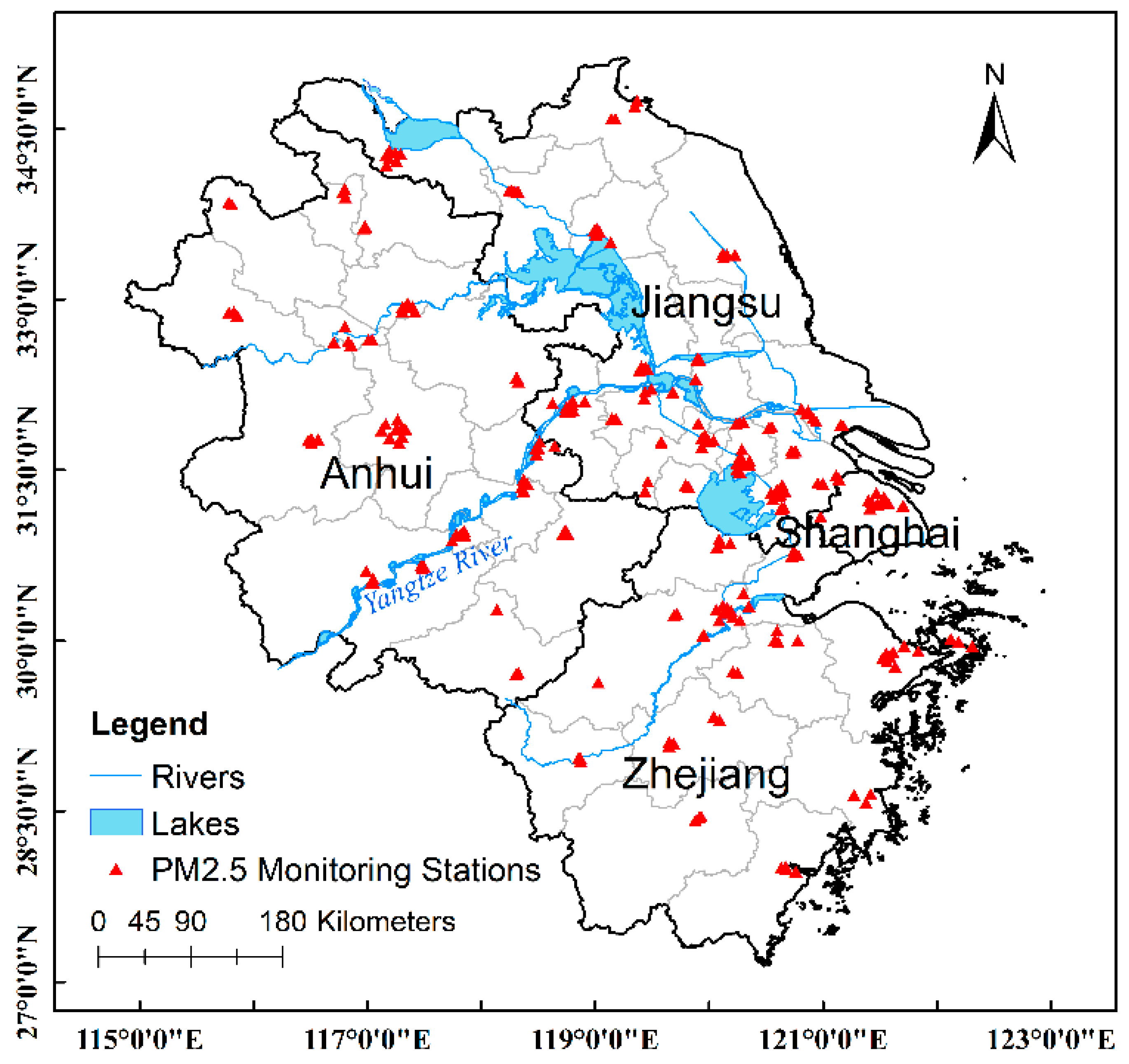
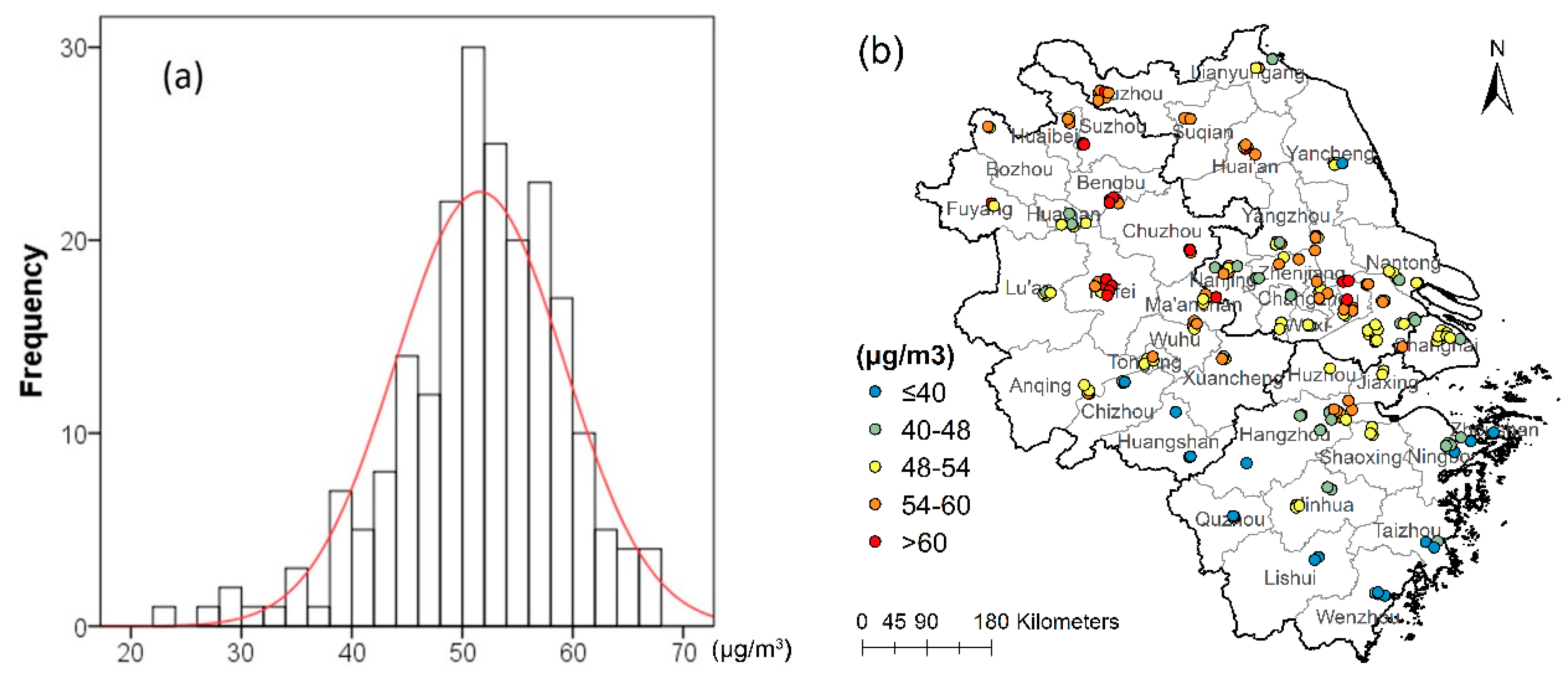
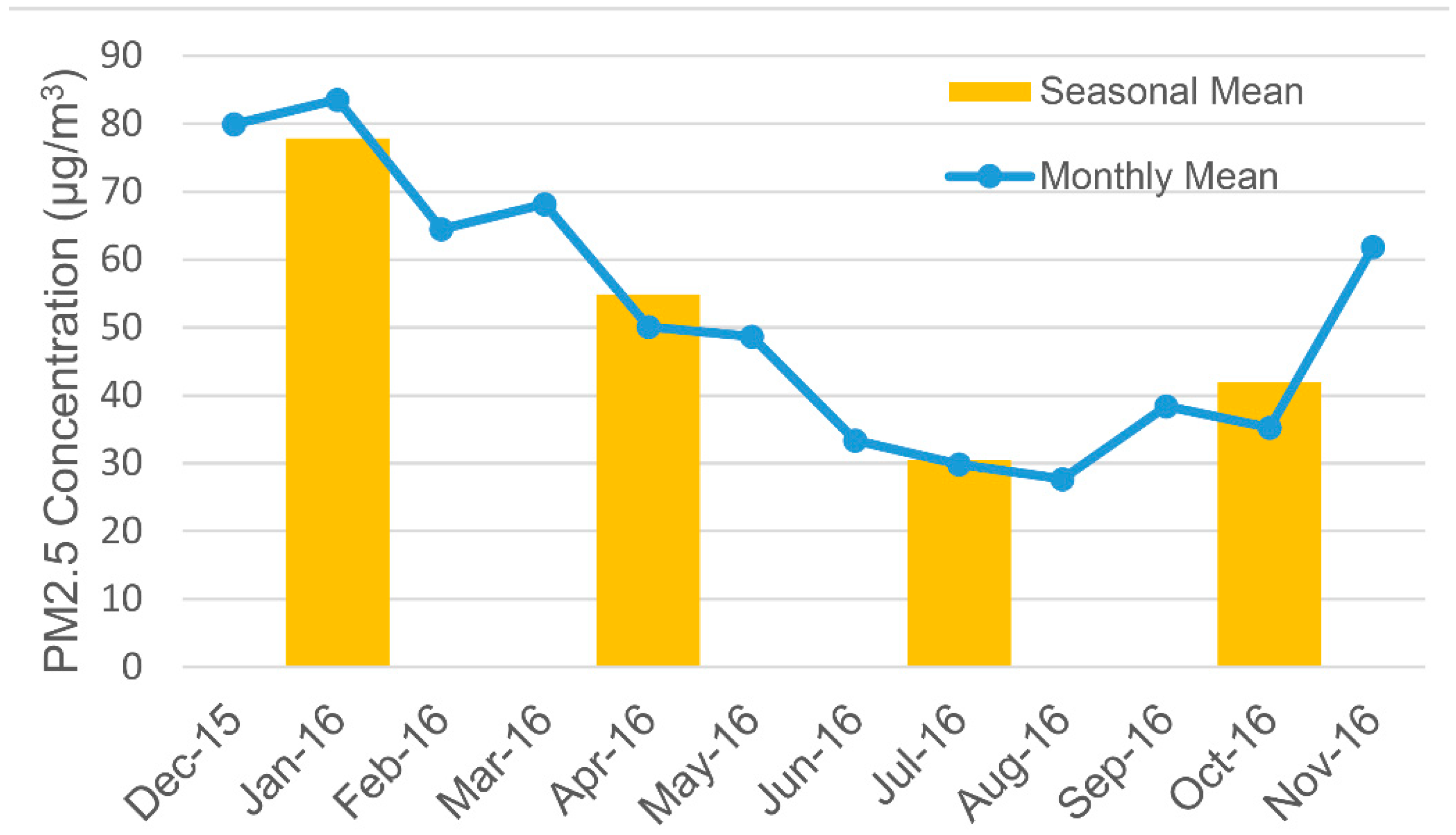
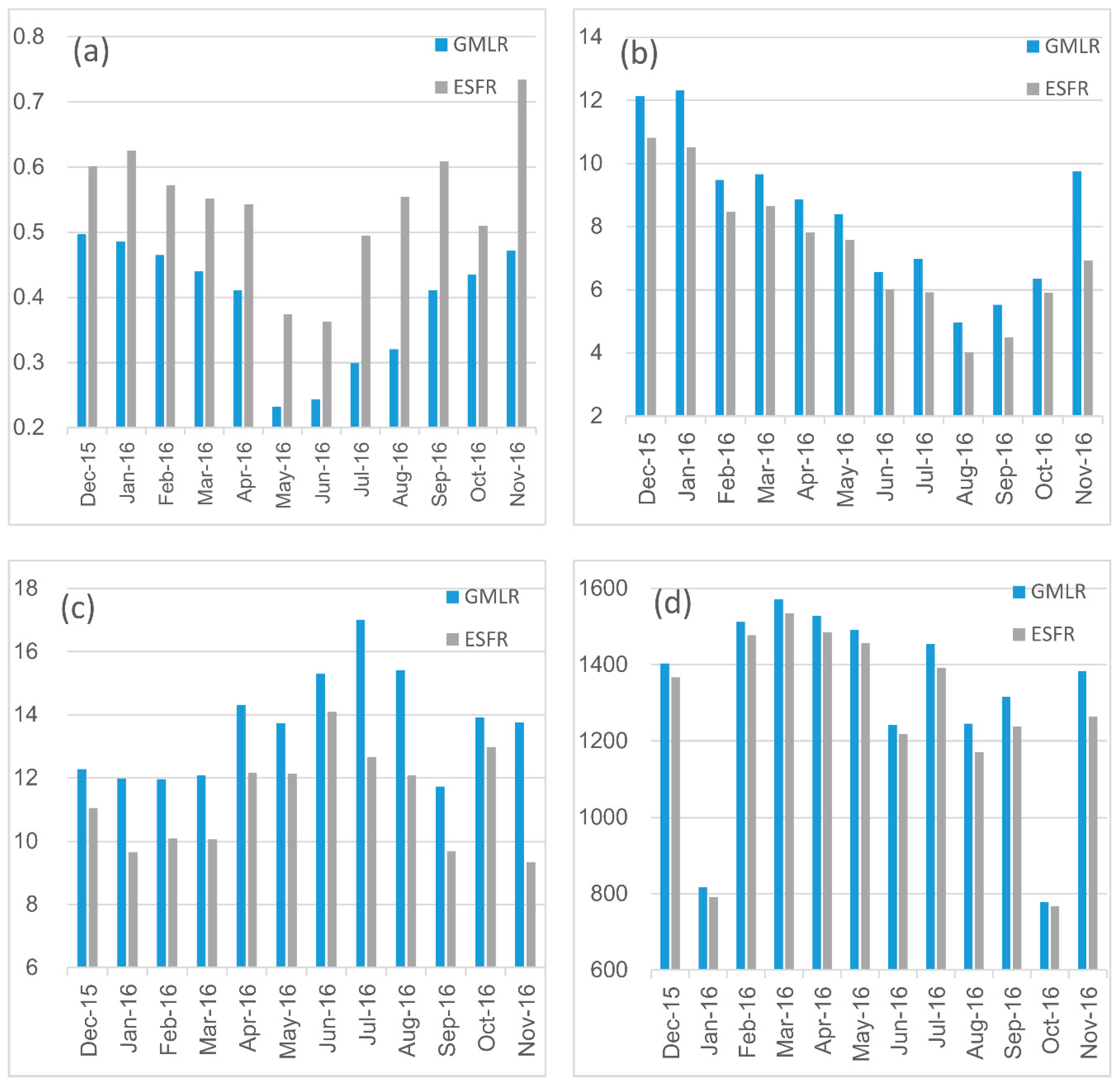
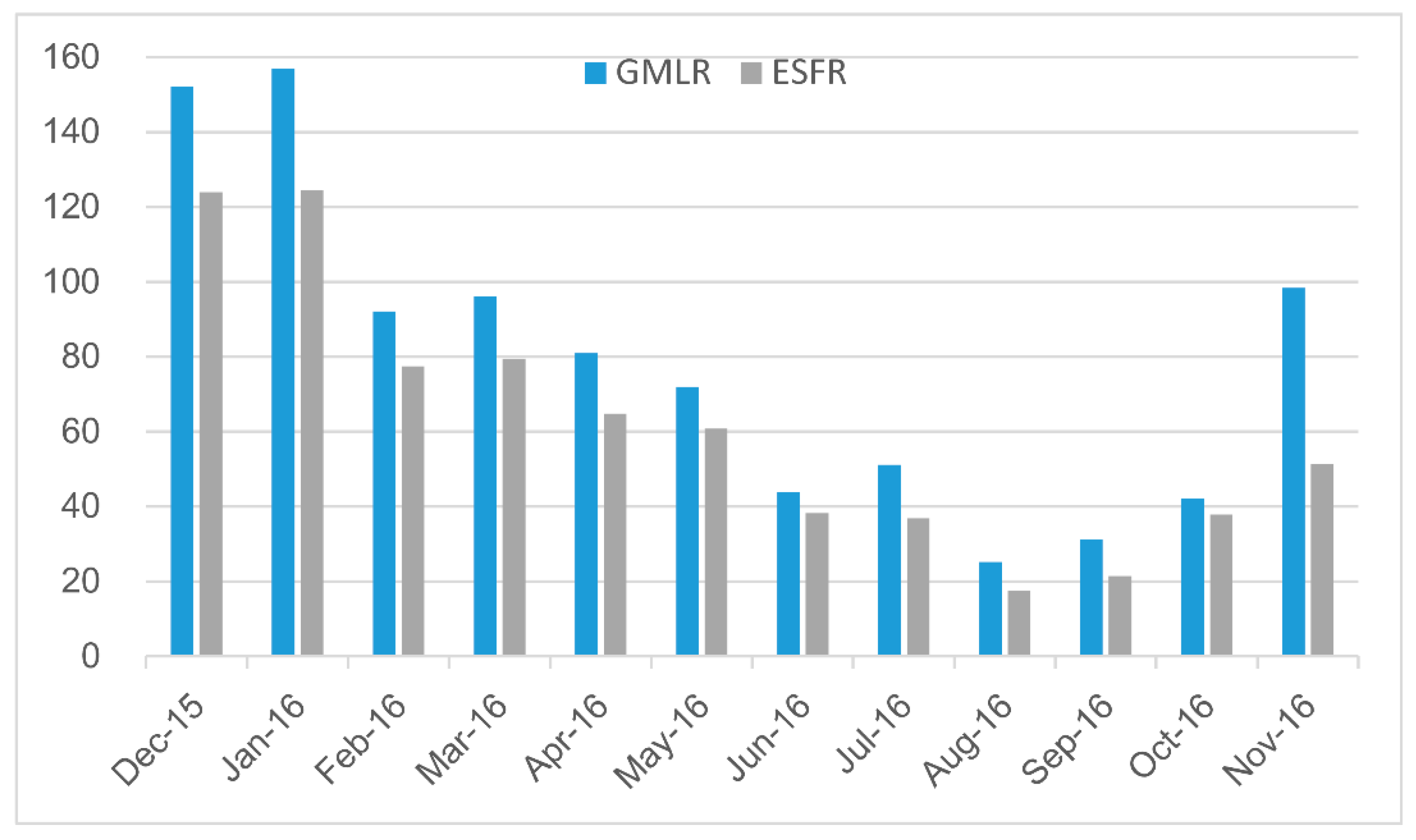
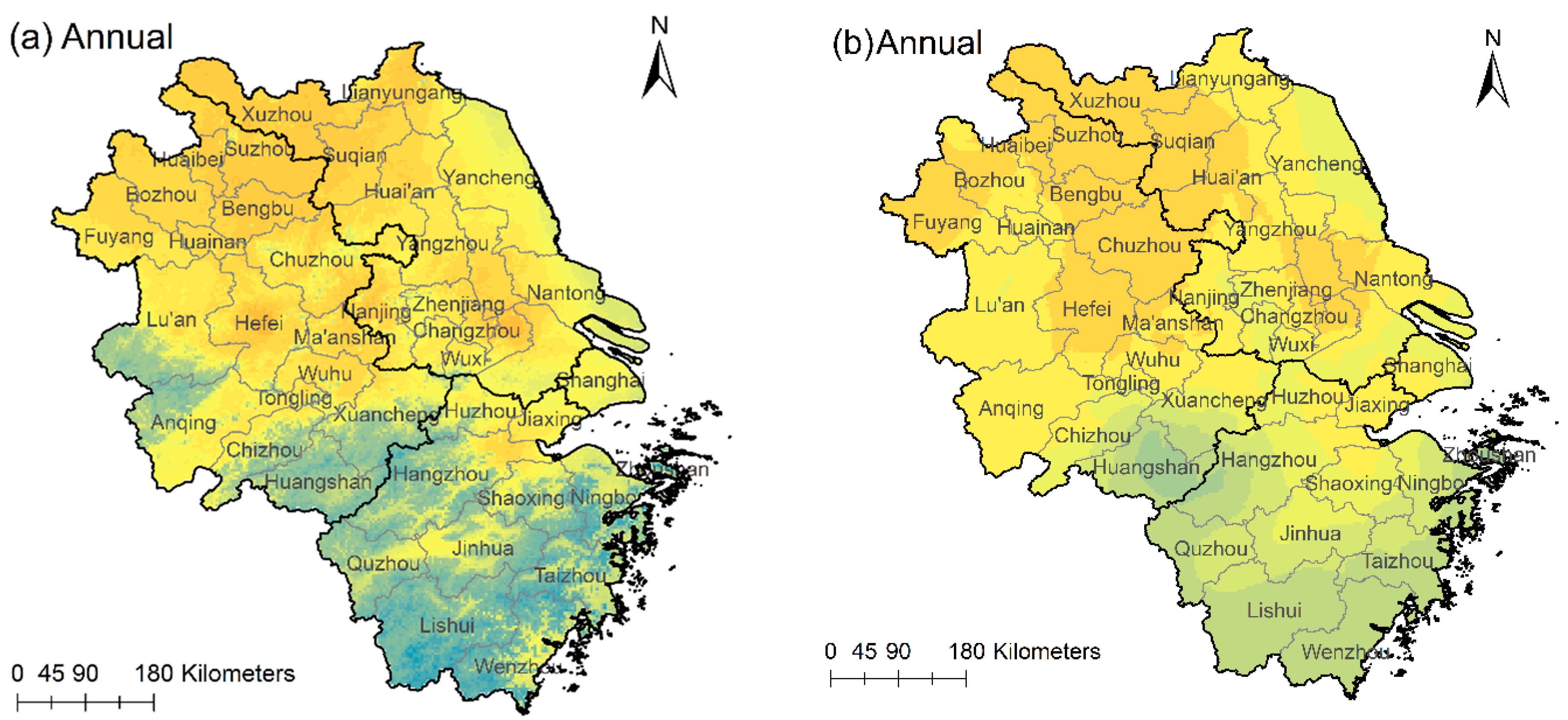
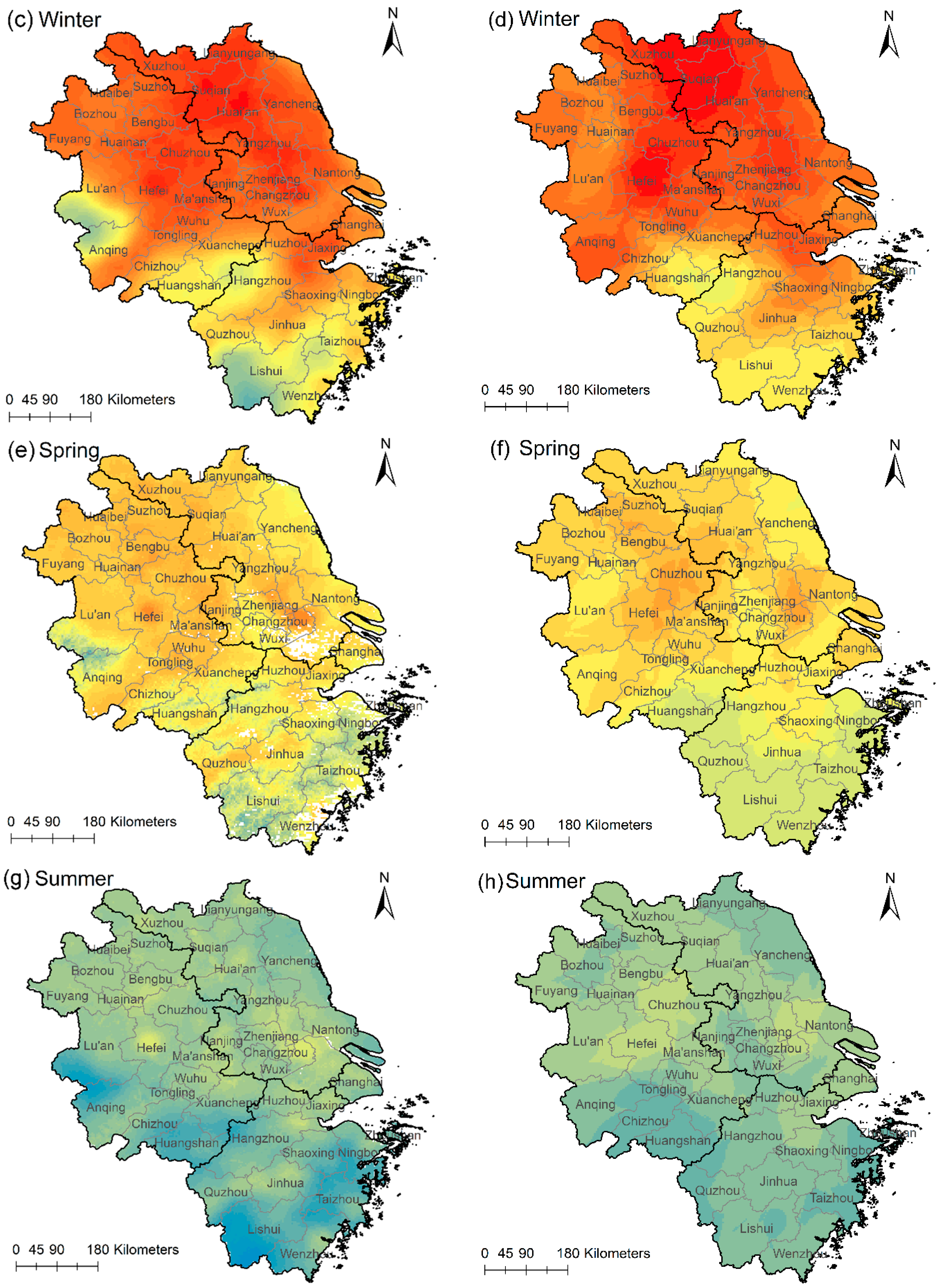
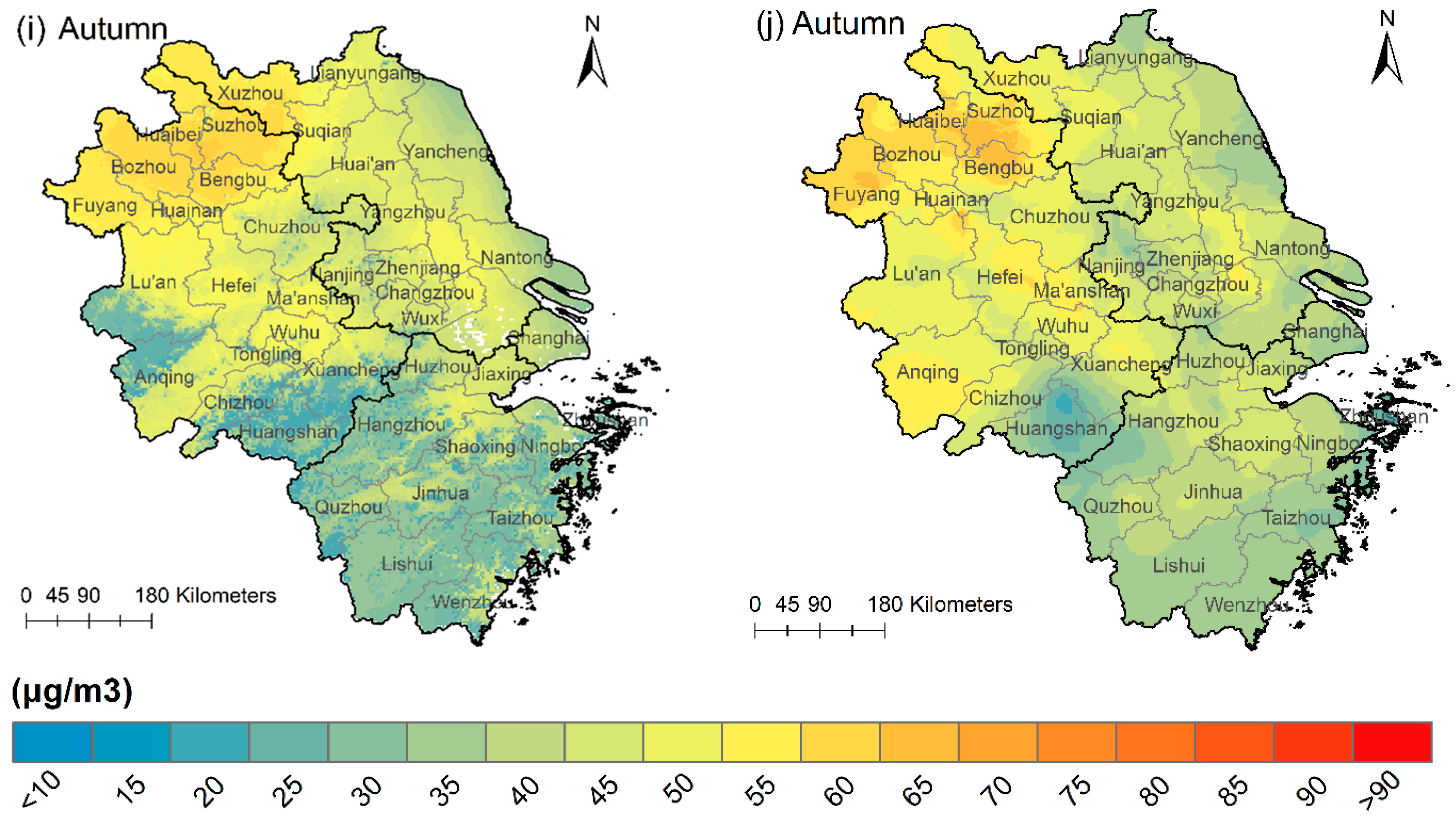
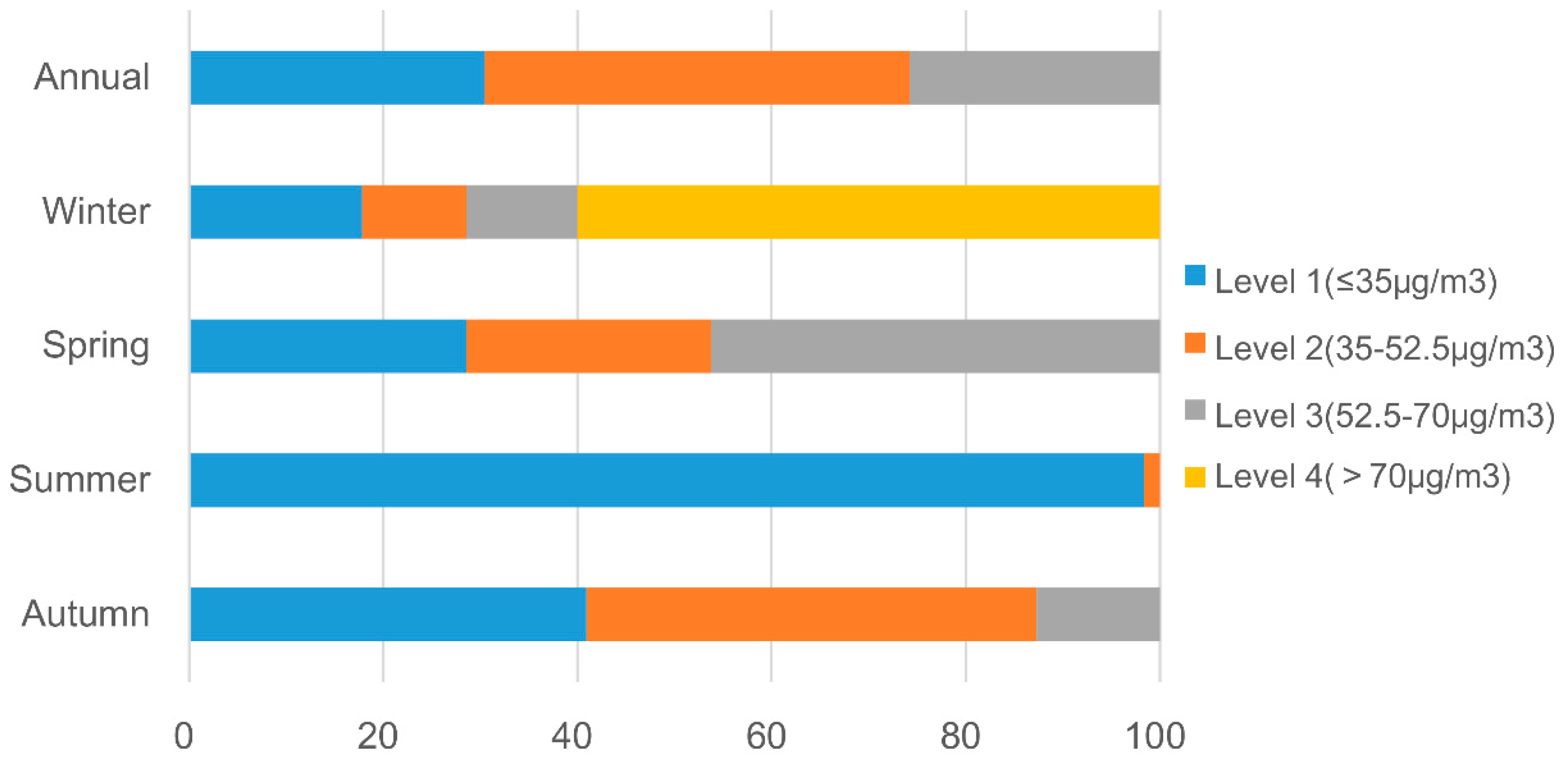
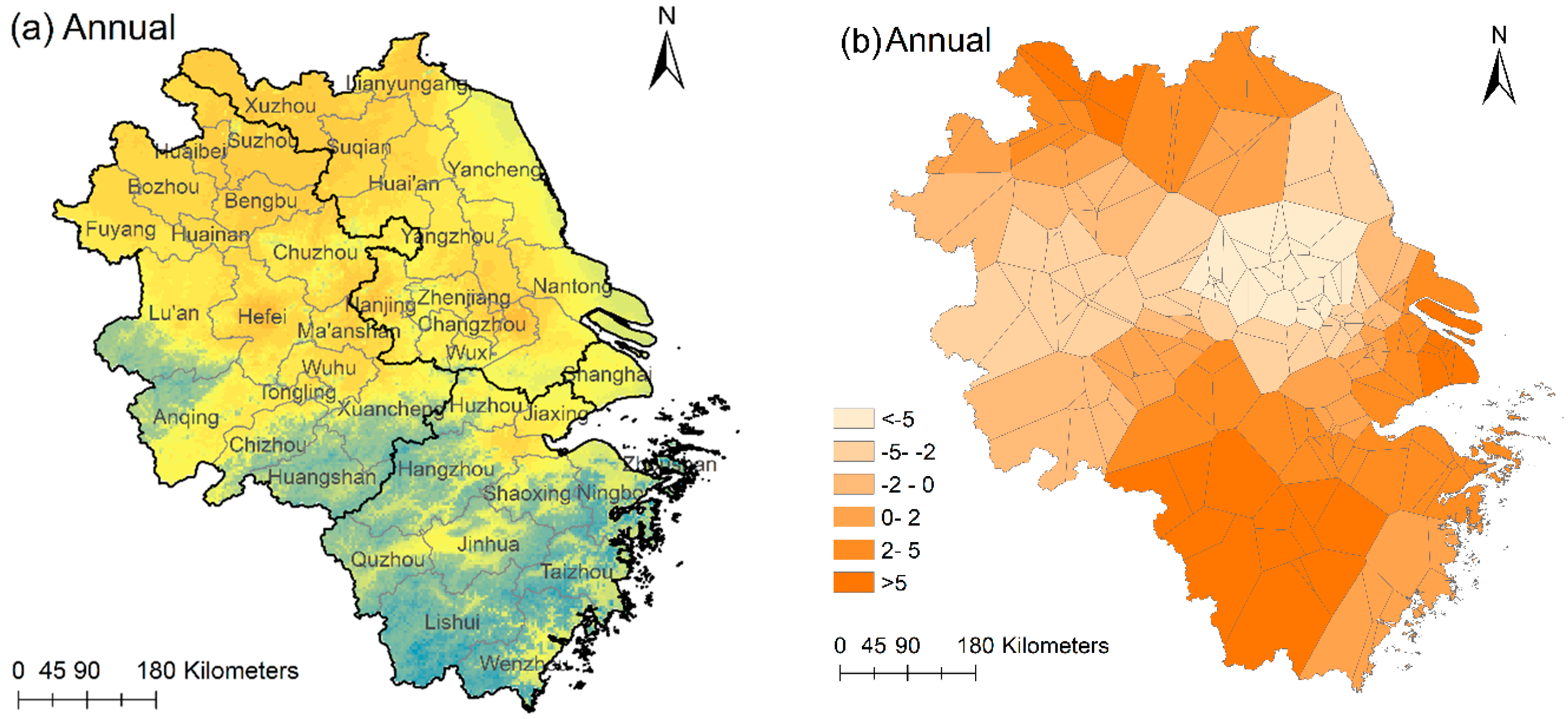
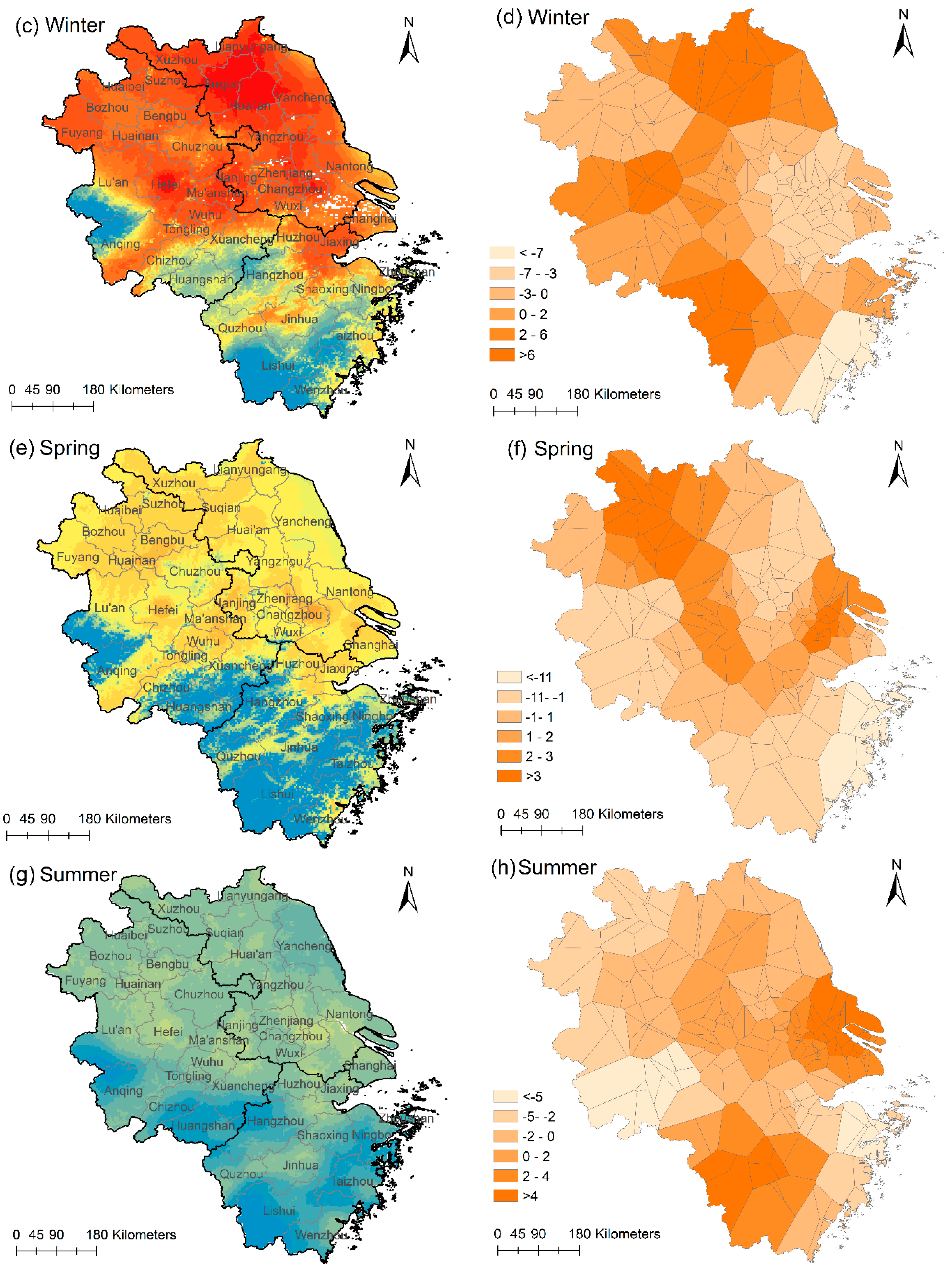
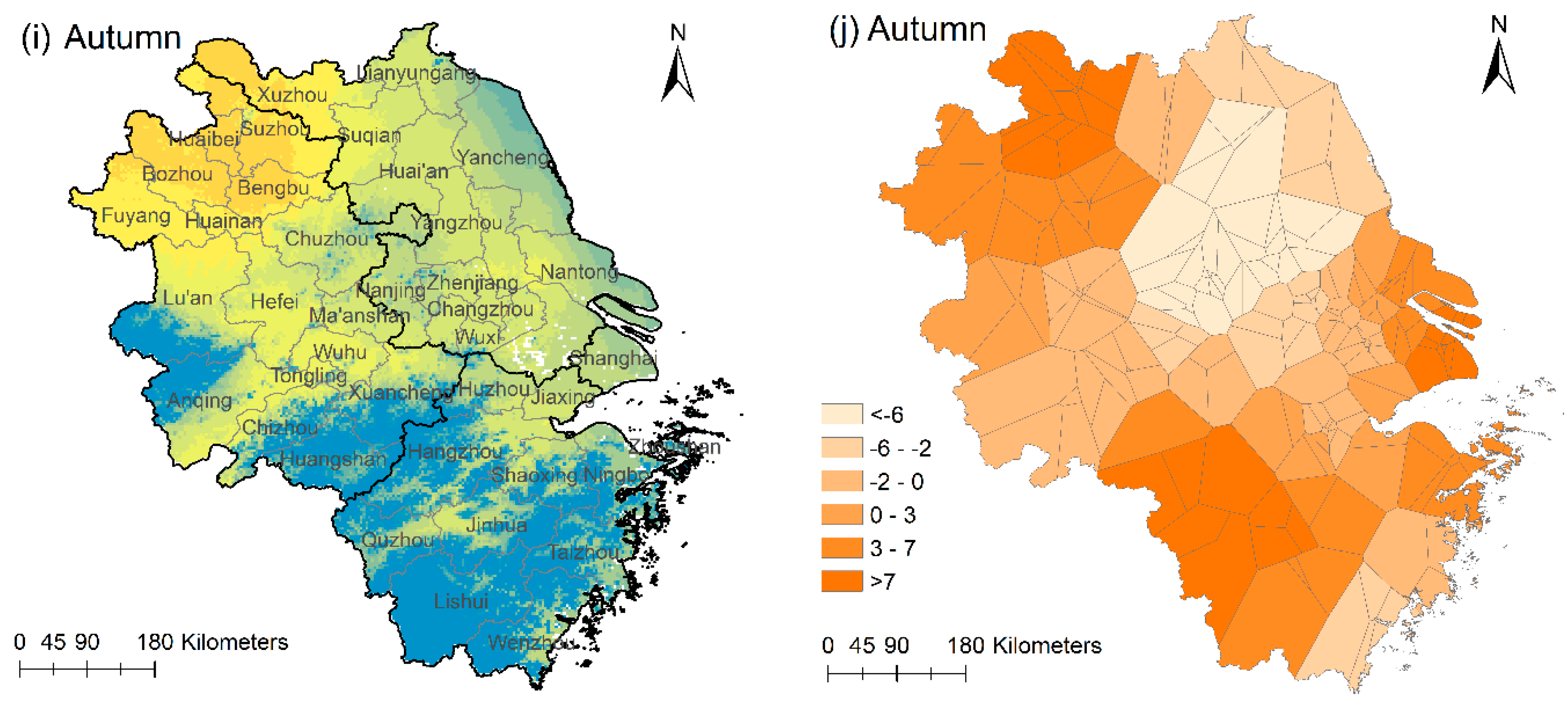
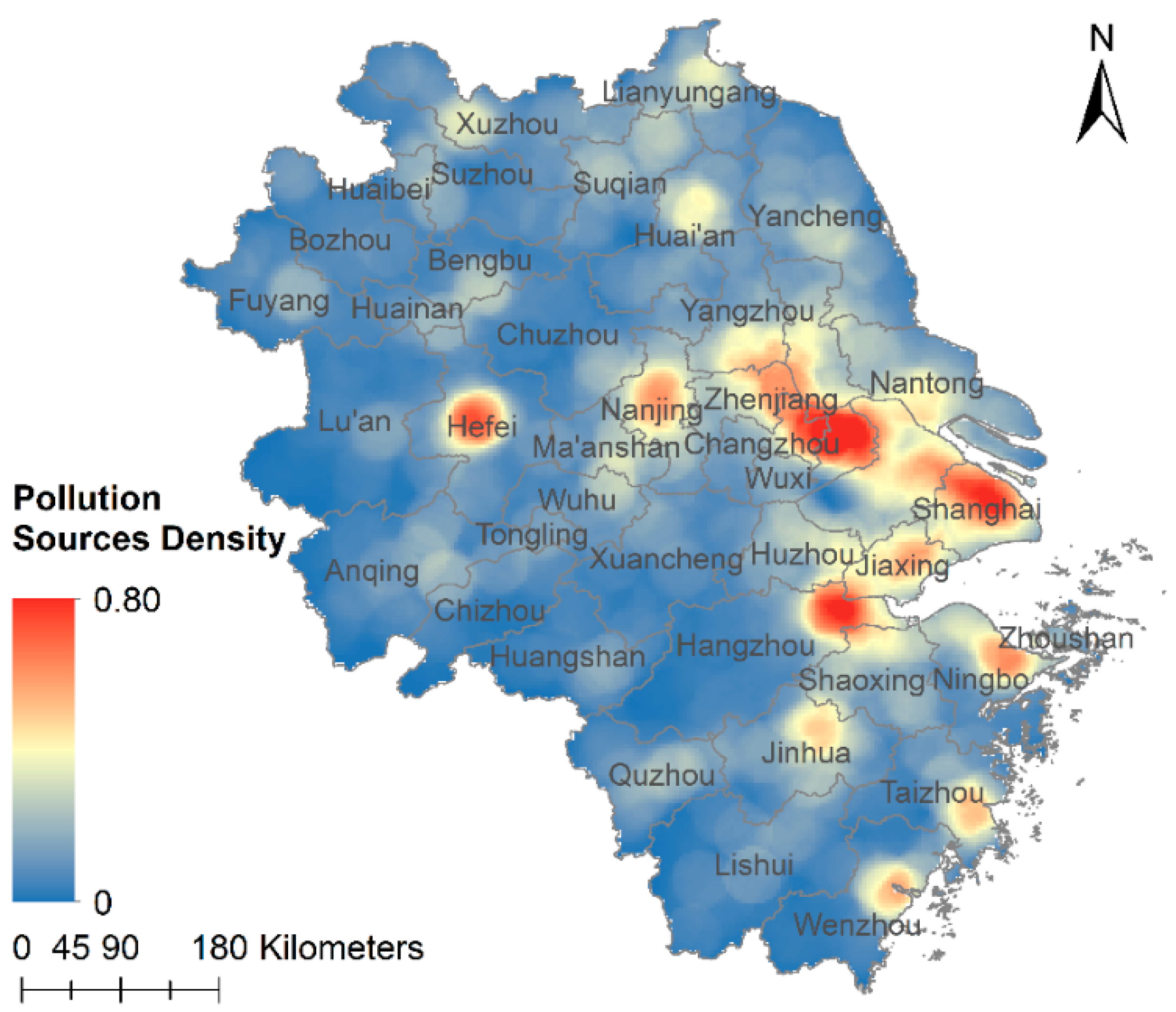
| Items | PM2.5 (μg/m3) | AOD (10−3) | ST (K) | PS (hPa) | RH (%) | PBLH (m) | NDVI (%) | Elevation (m) |
|---|---|---|---|---|---|---|---|---|
| Min | 23.2 | −5.0 | 270.2 | 912.9 | 45.8 | 132.2 | −19.6 | −92 |
| Max | 67.9 | 4952.0 | 327.8 | 1029.6 | 93.4 | 1013.5 | 99.9 | 1922 |
| Mean | 51.3 | 540.8 | 292.0 | 1001.3 | 69.7 | 389.7 | 62.0 | 138.3 |
| Std.dev | 7.9 | 278.3 | 13.5 | 22.1 | 0.8 | 140.6 | 1.9 | 232.0 |
| Time | AOD | PBLH | PS | RH | ST | NDVI | DEM | FactDen | RoadDen |
|---|---|---|---|---|---|---|---|---|---|
| Annual | 0.303 ** | −0.395 ** | 0.560 ** | −0.407 ** | −0.452 ** | −0.155 * | −0.320 ** | 0.257 ** | 0.138 * |
| Winter | 0.139 * | −0.373 ** | 0.620 ** | −0.383 ** | −0.487 ** | −0.079 | −0.385 ** | 0.272 ** | 0.185 ** |
| Spring | 0.403 ** | −0.187 ** | 0.496 ** | −0.318 ** | 0.163 * | −0.132 | −0.369 ** | 0.326 ** | 0.201 ** |
| Summer | 0.248 ** | −0.103 | 0.366 ** | 0.007 | 0.088 | −0.137 * | −0.216 ** | 0.384 ** | 0.289 ** |
| Autumn | −0.103 | −0.559 ** | 0.300 ** | −0.378 ** | −0.569 ** | −0.130 | −0.049 | 0.001 | −0.151 * |
| Time | AOD | PBLH | PS | RH | ST | NDVI | DEM | FactDen | RoadDen |
|---|---|---|---|---|---|---|---|---|---|
| 15 Dec | 0.099 | −0.248 ** | 0.614 ** | −0.038 | −0.322 ** | −0.148 * | −0.415 ** | 0.340 ** | 0.303 ** |
| 16 Jan | 0.100 | −0.058 | 0.662 ** | −0.550 ** | −0.364 ** | 0.164 | −0.517 ** | 0.275 ** | 0.212 * |
| 16 Feb | 0.312 ** | −0.472 ** | 0.437 ** | −0.190 ** | −0.509 ** | −0.155 * | −0.207 ** | 0.267 ** | 0.076 |
| 16 Mar | 0.321 ** | −0.511 ** | 0.227 ** | −0.230 ** | −0.234 ** | −0.117 | −0.085 | 0.179 ** | 0.049 |
| 16 Apr | 0.428 ** | −0.265 ** | 0.542 ** | −0.497 ** | 0.198 ** | 0.065 | −0.398 ** | 0.320 ** | 0.246 ** |
| 16 May | 0.230 ** | 0.095 | 0.461 ** | −0.079 | 0.146 * | −0.061 | −0.398 ** | 0.234 ** | 0.243 ** |
| 16 Jun | 0.117 | 0.037 | 0.389 ** | 0.006 | −0.044 | −0.109 | −0.313 ** | 0.390 ** | 0.316 ** |
| 16 Jul | 0.330 ** | −0.217 ** | 0.421 ** | 0.212 ** | 0.235 ** | −0.231 ** | −0.329 ** | 0.417 ** | 0.374 ** |
| 16 Aug | 0.224 ** | −0.509 ** | 0.070 | 0.228 ** | −0.395 ** | −0.094 | 0.150 * | 0.116 | −0.053 |
| 16 Sep | 0.264 ** | −0.466 ** | 0.333 ** | −0.544 ** | 0.070 | −0.113 | −0.059 | 0.222 ** | 0.034 |
| 16 Oct | −0.244 ** | −0.549 ** | 0.230 * | −0.026 | −0.498 ** | −0.095 | −0.111 | 0.039 | −0.113 |
| 16 Nov | −0.074 | −0.457 ** | 0.405 ** | −0.267 ** | −0.591 ** | −0.200 ** | −0.180 * | −0.023 | −0.182 * |
| Time | Moran’s I | p-Value | Time | Moran’s I | p-Value |
|---|---|---|---|---|---|
| Annual | 0.563 | <0.001 | 16 Apr | 0.526 | <0.001 |
| Winter | 0.549 | <0.001 | 16 May | 0.296 | <0.001 |
| Spring | 0.494 | <0.001 | 16 Jun | 0.361 | <0.001 |
| Summer | 0.416 | <0.001 | 16 Jul | 0.399 | <0.001 |
| Autumn | 0.610 | <0.001 | 16 Aug | 0.539 | <0.001 |
| 15 Dec | 0.547 | <0.001 | 16 Sep | 0.526 | <0.001 |
| 16 Jan | 0.524 | <0.001 | 16 Oct | 0.564 | <0.001 |
| 16 Feb | 0.495 | <0.001 | 16 Nov | 0.571 | <0.001 |
| 16 Mar | 0.598 | <0.001 |
| Variables | Annual | Winter | Spring | Summer | Autumn | |||||
|---|---|---|---|---|---|---|---|---|---|---|
| Beta | p | Beta | p | Beta | p | Beta | p | Beta | p | |
| AOD | 0.17 | 0.01 | 0.06 | 0.24 | / | / | / | / | 0.08 | 0.10 |
| ST | −0.46 | 0.00 | −0.23 | 0.02 | 0.18 | 0.00 | / | / | / | / |
| PS | 0.68 | 0.00 | 0.56 | 0.00 | / | / | 0.40 | 0.00 | 0.43 | 0.00 |
| RH | 0.31 | 0.00 | 0.32 | 0.00 | / | / | −0.53 | 0.00 | 0.16 | 0.10 |
| PBLH | −0.66 | 0.00 | −0.32 | 0.00 | −0.32 | 0.00 | −0.59 | 0.00 | −0.94 | 0.00 |
| NDVI | −0.10 | 0.01 | / | / | / | / | −0.14 | 0.01 | / | / |
| DEM | −0.24 | 0.00 | −0.16 | 0.05 | −0.38 | 0.00 | / | / | −0.30 | 0.00 |
| FactDen | 0.31 | 0.00 | 0.20 | 0.00 | 0.43 | 0.00 | 0.41 | 0.00 | / | / |
| RoadDen | / | / | / | / | / | / | / | / | / | / |
| R2adj | 0.70 | 0.64 | 0.49 | 0.51 | 0.65 | |||||
| AICc | 1255.8 | 1503.4 | 1357.0 | 1260.5 | 1314.5 | |||||
| MSE | 19.2 | 66.4 | 43.9 | 18.9 | 27.4 | |||||
| Variables | 15 Dec | 16 Jan | 16 Feb | 16 Mar | 16 Apr | 16 May | ||||||
| Beta | p | Beta | p | Beta | p | Beta | p | Beta | p | Beta | p | |
| AOD | / | / | / | / | / | / | / | / | / | / | / | / |
| ST | −0.72 | 0.00 | / | / | 0.15 | 0.33 | 0.34 | 0.00 | / | / | 0.13 | 0.10 |
| PS | 0.59 | 0.00 | 0.63 | 0.00 | 0.32 | 0.00 | / | / | / | / | 0.22 | 0.08 |
| RH | 0.31 | 0.00 | / | / | 0.80 | 0.00 | 0.17 | 0.09 | −0.36 | 0.01 | −0.21 | 0.09 |
| PBLH | 0.36 | 0.00 | −0.39 | 0.00 | −0.97 | 0.00 | −0.66 | 0.00 | −0.10 | 0.57 | / | / |
| NDVI | −0.07 | 0.20 | / | / | / | / | / | / | −0.09 | 0.08 | / | / |
| DEM | −0.19 | 0.06 | −0.28 | 0.00 | −0.30 | 0.00 | −0.26 | 0.01 | ||||
| FactDen | 0.26 | 0.00 | 0.14 | 0.02 | 0.34 | 0.00 | 0.39 | 0.00 | 0.32 | 0.00 | ||
| RoadDen | / | / | 0.24 | 0.01 | / | / | / | / | / | / | / | / |
| R2adj | 0.60 | 0.63 | 0.57 | 0.55 | 0.54 | 0.37 | ||||||
| AICc | 1367.1 | 791.3 | 1477.0 | 1534.6 | 1485.1 | 1456.6 | ||||||
| MSE | 124.0 | 124.5 | 77.4 | 79.4 | 64.8 | 60.9 | ||||||
| Variables | 16 Jun | 16 Jul | 16 Aug | 16 Sep | 16 Oct | 16 Nov | ||||||
| Beta | p | Beta | p | Beta | p | Beta | p | Beta | p | Beta | p | |
| AOD | −0.11 | 0.10 | 0.12 | 0.07 | / | / | 0.16 | 0.00 | −0.12 | 0.10 | ||
| ST | / | / | / | / | / | / | / | / | / | / | −0.84 | 0.00 |
| PS | 0.50 | 0.00 | 0.24 | 0.00 | 0.25 | 0.02 | / | / | / | / | 0.50 | 0.00 |
| RH | / | / | −0.52 | 0.00 | / | / | / | / | / | // | 0.30 | 0.00 |
| PBLH | 0.35 | 0.00 | −0.24 | 0.01 | −0.58 | 0.00 | −0.53 | 0.00 | −0.40 | 0.00 | / | / |
| NDVI | −0.10 | 0.10 | −0.14 | 0.01 | / | / | −0.12 | 0.01 | / | / | / | / |
| DEM | / | / | / | / | / | / | / | / | −0.41 | 0.00 | −0.28 | 0.00 |
| FactDen | 0.41 | 0.00 | 0.37 | 0.00 | 0.14 | 0.01 | 0.18 | 0.00 | 0.13 | 0.06 | 0.16 | 0.00 |
| RoadDen | / | / | / | / | / | / | 0.12 | 0.10 | / | / | / | / |
| R2adj | 0.36 | 0.49 | 0.55 | 0.61 | 0.51 | 0.73 | ||||||
| AICc | 1218.3 | 1391.5 | 1170.8 | 1238.4 | 767.0 | 1264.5 | ||||||
| MSE | 38.2 | 36.8 | 17.5 | 21.5 | 37.9 | 51.3 | ||||||
| Time | Adj. R2 | RSE | MAPE | AICc | ||||
|---|---|---|---|---|---|---|---|---|
| GMLR | ESFR | GMLR | ESFR | GMLR | ESFR | GMLR | ESFR | |
| Annual | 0.60 | 0.70 | 4.85 | 4.24 | 7.70 | 6.66 | 1307.1 | 1255.8 |
| Winter | 0.57 | 0.64 | 8.58 | 7.86 | 8.84 | 7.85 | 1530.6 | 1503.4 |
| Spring | 0.39 | 0.49 | 7.06 | 6.46 | 9.91 | 8.94 | 1384.0 | 1357.0 |
| Summer | 0.31 | 0.51 | 5.10 | 4.27 | 13.61 | 10.64 | 1331.3 | 1260.5 |
| Autumn | 0.48 | 0.65 | 6.12 | 5.06 | 11.77 | 9.19 | 1384.8 | 1314.5 |
| Time | GMLR | ESFR | ||
|---|---|---|---|---|
| Moran’s I | p-Value | Moran’s I | p-Value | |
| Annual | 0.101 | <0.001 | −0.057 | 0.970 |
| Winter | 0.097 | <0.001 | −0.060 | 0.976 |
| Spring | 0.111 | <0.001 | −0.021 | 0.709 |
| Summer | 0.278 | <0.001 | −0.004 | 0.494 |
| Autumn | 0.224 | <0.001 | −0.022 | 0.730 |
| 15 Dec | 0.165 | <0.001 | −0.036 | 0.841 |
| 16 Jan | 0.116 | 0.001 | −0.038 | 0.769 |
| 16 Feb | 0.077 | 0.002 | −0.061 | 0.976 |
| 16 Mar | 0.104 | <0.001 | −0.037 | 0.877 |
| 16 Apr | 0.206 | <0.001 | −0.008 | 0.544 |
| 16 May | 0.162 | <0.001 | 0.011 | 0.282 |
| 16 Jun | 0.144 | <0.001 | −0.020 | 0.693 |
| 16 Jul | 0.254 | <0.001 | 0.006 | 0.340 |
| 16 Aug | 0.312 | <0.001 | −0.060 | 0.974 |
| 16 Sep | 0.314 | <0.001 | −0.034 | 0.848 |
| 16 Oct | 0.095 | 0.002 | −0.053 | 0.887 |
| 16 Nov | 0.376 | <0.001 | −0.067 | 0.980 |
| Time | GMLR | ESFR |
|---|---|---|
| Annual | 24.9 | 19.2 |
| Winter | 75.8 | 66.4 |
| Spring | 51.0 | 43.9 |
| Summer | 26.6 | 18.9 |
| Autumn | 39.1 | 27.4 |
| Season | Worst | Best | ||||
|---|---|---|---|---|---|---|
| 1st | 2nd | 3rd | 1st | 2nd | 3rd | |
| Winter | Suqian (90.8) | Huai’an (88.5) | Lianyungang (86.6) | Lishui (11.2) | Wenzhou (23.3) | Huangshan (35.0) |
| Spring | Huainan (59.2) | Bengbu (59.1) | Huaibei (61.4) | Lishui (9.3) | Wenzhou (14.8) | Huangshan (15.9) |
| Summer | Wuxi (32.4) | Huainan (31.6) | Bengbu (30.9) | Lishui (11.1) | Huangshan (14.1) | Wenzhou (17.4) |
| Autumn | Huaibei (55.6) | Bozhou (55.3) | Bengbu (54.6) | Lishui (7.5) | Wenzhou (8.2) | Huangshan (11.0) |
© 2018 by the authors. Licensee MDPI, Basel, Switzerland. This article is an open access article distributed under the terms and conditions of the Creative Commons Attribution (CC BY) license (http://creativecommons.org/licenses/by/4.0/).
Share and Cite
Zhang, J.; Li, B.; Chen, Y.; Chen, M.; Fang, T.; Liu, Y. Eigenvector Spatial Filtering Regression Modeling of Ground PM2.5 Concentrations Using Remotely Sensed Data. Int. J. Environ. Res. Public Health 2018, 15, 1228. https://doi.org/10.3390/ijerph15061228
Zhang J, Li B, Chen Y, Chen M, Fang T, Liu Y. Eigenvector Spatial Filtering Regression Modeling of Ground PM2.5 Concentrations Using Remotely Sensed Data. International Journal of Environmental Research and Public Health. 2018; 15(6):1228. https://doi.org/10.3390/ijerph15061228
Chicago/Turabian StyleZhang, Jingyi, Bin Li, Yumin Chen, Meijie Chen, Tao Fang, and Yongfeng Liu. 2018. "Eigenvector Spatial Filtering Regression Modeling of Ground PM2.5 Concentrations Using Remotely Sensed Data" International Journal of Environmental Research and Public Health 15, no. 6: 1228. https://doi.org/10.3390/ijerph15061228
APA StyleZhang, J., Li, B., Chen, Y., Chen, M., Fang, T., & Liu, Y. (2018). Eigenvector Spatial Filtering Regression Modeling of Ground PM2.5 Concentrations Using Remotely Sensed Data. International Journal of Environmental Research and Public Health, 15(6), 1228. https://doi.org/10.3390/ijerph15061228




